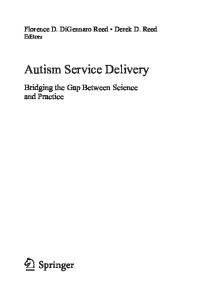Bridging the Gap Between Requirements Engineering and Human-Computer Interaction
This book is intended to discuss important issues concerning Requirements Engineering (RE) and Human-Computer Interaction (HCI), especially the ones related to usability and accessibility. It is dedicated to observations, concepts, approaches, frameworks
- PDF / 79,020 Bytes
- 5 Pages / 439.37 x 666.14 pts Page_size
- 48 Downloads / 328 Views
2
1
)
Computer Graphics and HCI Group, University of Kaiserslautern, Kaiserslautern, Germany {ebert,humayoun}@cs.uni-kl.de University of Applied Sciences and Arts Northwestern Switzerland, Windisch, Switzerland [email protected] 3 University of Zurich, Zurich, Switzerland 4 Fondazione Bruno Kessler – ICT, Trento, Italy [email protected] 5 Pontifical Catholic University of Rio de Janeiro, Rio de Janeiro, Brazil [email protected]
Introduction
This book is intended to discuss important issues concerning Requirements Engineering (RE) and Human-Computer Interaction (HCI), especially the ones related to usability and accessibility. It is dedicated to observations, concepts, approaches, frameworks and practices that promote understanding, facilitating, and increasing the awareness of the role of usability and accessibility requirements and their proper integration into the requirement engineering process. The book is based on the two workshops on Usabilityand Accessibility-focused Requirements Engineering (UsARE), which took place in 2012 and 2014. The first event, UsARE 2012 [8], was supported by IEEE and was held on June 04, 2012 in conjunction with the IEEE 34th International Conference on Soft‐ ware Engineering (ICSE 2012) in Zurich, Switzerland. The second event, UsARE 2014 [9], was supported by IEEE and IFIP and was held on August 25, 2014 in conjunction with the 22nd IEEE International Requirements Engineering Conference (RE 2014) in Karlskrona, Sweden. On both occasions, each submission was reviewed by at least three program committee members. This was followed by discussions amongst the organizers which led to a total number of 7 accepted papers for UsARE 2012 and 8 accepted papers for UsARE 2014. On both occasions, the workshop proceedings were published online by the IEEE Xplore Digital Library. The workshop summary and the results of the interactive session of the first event were published as a report in the ACM Software Engineering Notes in the issue of January 2013 [2]. There were 18 participants in UsARE 2012 and 22 participants in UsARE 2014. During the events, the authors presented their work; this was followed by intense discus‐ sions, in which participants actively took part. The last session in both events was dedi‐ cated to interactive discussions through the interactive group discussion strategy. The idea of publishing the book with extended versions of the papers was born during the second event. All participants agreed that the topics definitely deserved to be © IFIP International Federation for Information Processing 2016 Published by Springer International Publishing Switzerland 2016. All Rights Reserved A. Ebert et al. (Eds.): UsARE 2012/2014, LNCS 9312, pp. 3–7, 2016. DOI: 10.1007/978-3-319-45916-5_1
4
A. Ebert et al.
explored further in order to give the related research communities in-depth outcomes of the research as workshop papers’ lengths (4 pages for short and 7 pages for long) were not enough to present the ideas in much depth. We hope that the heavily extended papers in this b
Data Loading...











